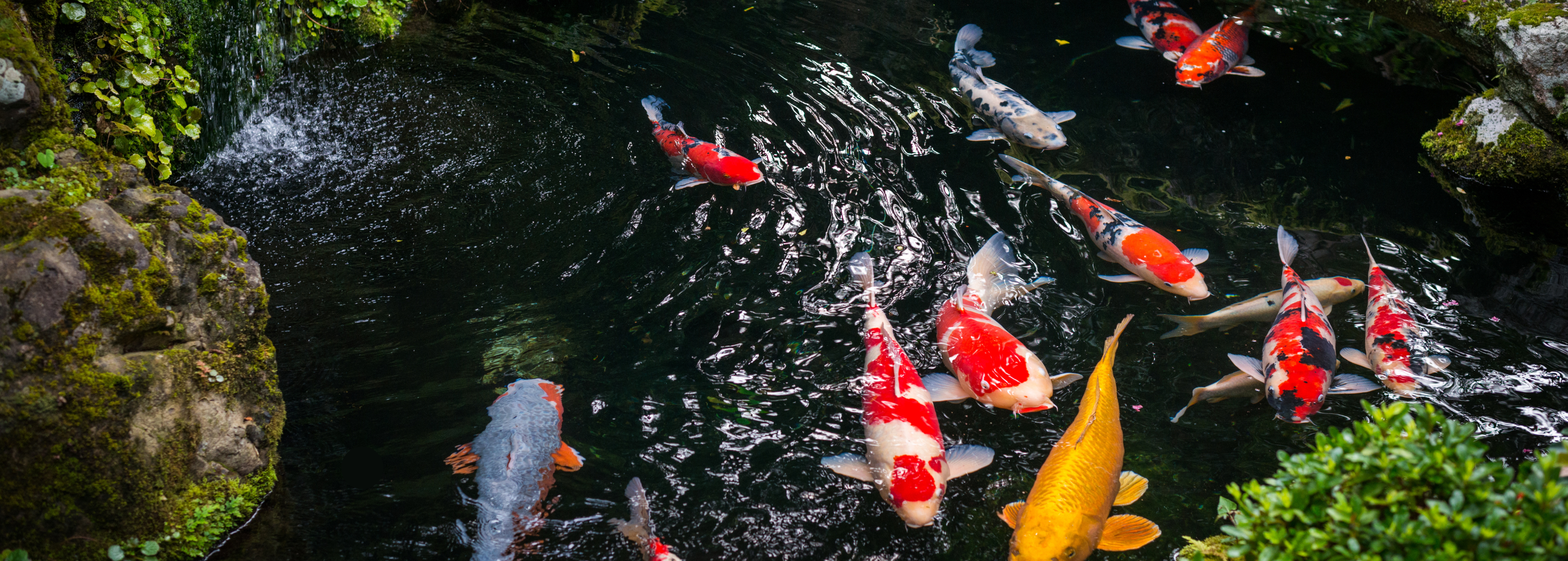Koi ponds are more than just water features, they’re living ecosystems and the heart of many gardens. Watching koi glide gracefully through clear water is deeply calming, but keeping that water healthy and balanced requires year-round attention. Seasonal maintenance is essential for both the health of your fish and the longevity of your pond equipment.
In this guide, we’ll walk through a step-by-step seasonal care routine so you can keep your koi pond thriving throughout the year.
Spring: Waking Up the Pond
As the weather warms, your koi begin to stir after winter dormancy. Spring is all about giving your pond a fresh start.
Step 1: Deep Clean (if needed)
- Remove debris such as fallen leaves and sludge that may have built up over winter.
- Consider a partial water change, but avoid stripping away too much beneficial bacteria.
Step 2: Restart Filtration Systems
- Check filters, pumps, and UV clarifiers, giving them a thorough clean and replacing media if necessary.
- Ensure everything is running smoothly before water temperatures rise.
Step 3: Water Testing & Treatment
- Test for ammonia, nitrites, and pH stability.
- Add beneficial bacteria to boost your pond’s biological filtration.
Step 4: Feeding Koi Slowly
- As water temperatures reach around 10°C, reintroduce easily digestible wheatgerm-based food.
- Gradually increase feeding frequency as temperatures continue to rise.
Summer: Peak Pond Life
Summer is when your koi are most active, plants are in full growth, and the pond environment is buzzing with life. This is also the season when your pond needs the most attention.
Step 1: Oxygen Levels
- Warm water holds less oxygen – add air pumps, waterfalls, or fountains to keep oxygen flowing.
- Monitor koi for signs of oxygen stress (gasping at the surface).
Step 2: Feeding Routine
- Feed a high-protein koi food to support growth and colour enhancement.
- Feed little and often, avoiding excess that can pollute the water.
Step 3: Algae Control
- Use aquatic plants like lilies to provide shade and compete with algae.
- Ensure your UV clarifier is functioning properly.
Step 4: Regular Maintenance
- Clean filters weekly and remove any debris that accumulates.
- Perform small water changes to maintain water quality, especially during hot spells.
Autumn: Preparing for Winter
As temperatures cool, your pond begins its slow transition into dormancy. Autumn is about preparation and prevention.
Step 1: Leaf Protection
- Net your pond to prevent leaves and debris from sinking and rotting at the bottom.
- Skim the surface regularly to keep water clean.
Step 2: Reduce Feeding
- Switch back to wheatgerm food as koi metabolism slows.
- Gradually cut down feeding as water temperatures drop below 10°C.
Step 3: Equipment Care
- Service your pump and filter to ensure they’re ready for lighter use in winter.
- Consider removing delicate equipment if your pond is likely to freeze.
Step 4: Check Fish Health
- Observe koi for any parasites or wounds before winter sets in.
- Treat issues early, as colder water makes healing slower.
Winter: Keeping Things Stable
In winter, koi go into a state of torpor, slowing their metabolism to cope with cold temperatures. Your role is to keep the pond stable and safe.
Step 1: Avoid Complete Freezing
- Use a pond heater, air stone, or de-icer to keep a small hole in the ice for gas exchange.
- Never smash ice, as the vibrations can stress koi.
Step 2: Stop Feeding
- Do not feed koi once water temperatures are consistently below 8°C, as they cannot digest food properly.
Step 3: Minimal Disturbance
- Avoid stirring up the pond or carrying out big water changes.
- Allow koi to rest peacefully through the cold season.
Step 4: Equipment Monitoring
- Keep pumps and filters running if possible, but at a reduced flow.
- Check regularly to ensure equipment hasn’t frozen or clogged.
Year-Round Tips for Healthy Koi
- Water Quality is Key: Regular testing ensures you catch problems early.
- Balance Stocking Levels: Avoid overcrowding to reduce stress and maintain clean water.
- Quality Food Matters: Seasonal diets help koi thrive all year round.
- Routine Observation: Daily checks help you spot unusual behaviour quickly.
Overall…
A koi pond is a beautiful, living feature that rewards care and attention. By tailoring your pond maintenance to the seasons, you’ll create a stable, healthy environment where your koi can live long, vibrant lives.
At Aqua Group Koi, we know every pond is unique so that’s why we stock a wide range of filters, pumps, food, and treatments, as well as hand-selected koi to bring your pond to life. With expert advice and everything you need in one place, caring for your pond has never been easier.

